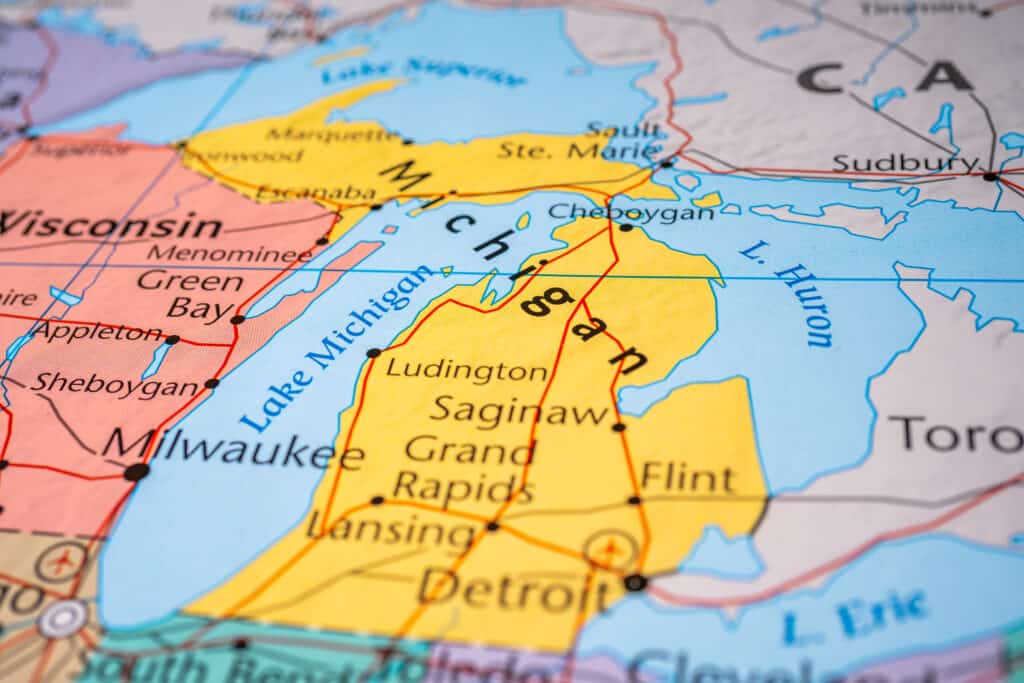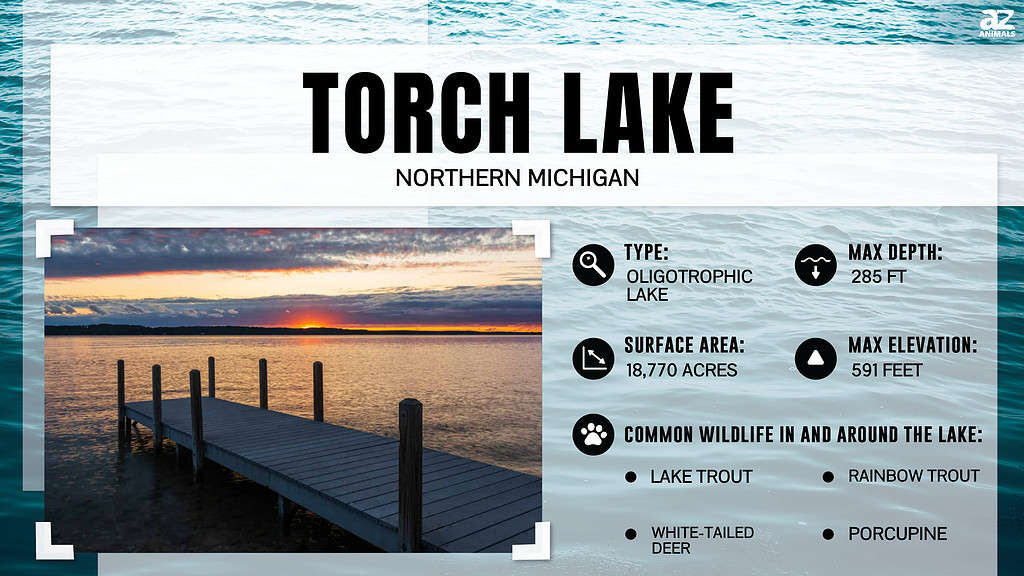What is the deepest lake in Northern Michigan? Well, that depends on what we call Northern Michigan and what we mean by a lake. Read on for a more in-depth discussion.
Northern Michigan
Michigan is divided into an Upper and Lower Peninsula. The region known as Northern Michigan is the northern portion of the lower peninsula—at least to Lower Peninsula residents. Residents of the Upper Peninsula (U.P.) say it should be referred to as “Northern Lower Michigan.” For this discussion, though, we will go with the generally accepted definition of it as part of the Lower Peninsula.

Is it Northern Michigan or Northern Lower Michigan?
©Alexander Lukatskiy/Shutterstock.com
Deepest Lake In Northern Michigan
As to what is the deepest lake in Northern Michigan, we must not forget that Michigan has parts of the four Great Lakes within its boundaries. Again, technically, the deepest lake in Michigan is Lake Superior. That seems like a copout because when someone asks about the deepest lake in Northern Michigan, they are probably thinking of inland lakes. The deepest inland lake of Northern Michigan, then, would be Torch Lake.

History of Torch Lake
The name Torch Lake has its roots in the practices of local Native Americans, who used to use torches to spear or net fish at night. The Ojibwe tribe used to call it the “Place of Torches/Flames” in their language. European settlers would later refer to it as “Torch Light Lake,” shortening it in later usage.

The Torch Lake Sandbar is a popular tourist destination.
©AnotherViewDroneService/Shutterstock.com
Geology of Torch Lake
The formation of Torch Lake occurred in conjunction with the development of Lake Michigan as the last Glacial Period ended. Torch Lake used to be a bay of Lake Michigan until a sandbar formed across the outlet to Lake Michigan, closing it off to become its own lake. Several other long lakes along Lake Michigan were formed in the same way.
Torch Lake’s blue, almost Caribbean appearance is due to limestone deposits left behind by the glaciers that were originally there. Torch Lake also has fine white silt and minimal organic matter. This means the lake’s waters have nothing to darken or muddy them, resulting in that brilliant, cool hue.
Things To Do Around Torch Lake
Torch Lake is well-known for its Caribbean blue waters and is a popular boating destination in Michigan. Kayaking, canoeing, fishing, and diving are other popular pursuits on the lake. The area around the lake is suited for hiking and other nature pursuits—birdwatching is a popular activity around the lake. The locale is a well-known resort spot, and the sandbar at the south end of the lake (known as the Torch Lake Sandbar) is a popular tourist destination.

Torch Lake is the deepest of Northern Michigan’s inland lakes. It’s also a great place to kayak.
©iStock.com/BeccasDigital
Where Is Torch Lake on a Map?
Wildlife Around Torch Lake
Small fish don’t have much of a habitat here. The shoreline has been cleared of trees, and there is not much cover in shallow water. The deeper waters are dominated by larger fish that like cold, darker waters. These deeper waters have provided an excellent habitat for muskellunge, smallmouth bass, lake trout, brown trout, rainbow trout, rock bass, and yellow perch.
The shores attract a variety of waterfowl and songbirds. Birders have recorded populations of buffleheads, goldeneyes, mergansers, ring-billed gulls, American goldfinches, eastern kingbirds, red-winged blackbirds, and others.
Around the lake, nature lovers may spot the white-tail deer, American toad, and porcupine. Occasionally, black bears have been spotted in the area. The lack of small fish close to the shore and the wealth of human activity tends to keep wildlife away from the shores of Torch Lake.

Smallmouth bass like the deep, cold waters of Torch Lake.
©iStock.com/RLSPHOTO
Comparison of Torch Lake To Other Lakes
There are other lakes throughout the United States similar in nature to Torch Lake. Other lakes around Lake Michigan, as well as New York’s Finger Lakes, have a similar footprint.
Lakes in Michigan
The glacial processes that created Torch Lake were also responsible for creating others, including Elk Lake and Lake Charlevoix.
Elk Lake
Elk Lake is another lake that formed as a bay of Lake Michigan. It is also Michigan’s second deepest inland lake, behind Torch Lake to its east. Elk Lake is a popular destination for fishing, providing habitat for trout, bass, yellow perch, muskellunge, ciscoes, and whitefish.
Lake Charlevoix
Located east of Torch Lake, Lake Charlevoix is the state’s third-largest inland lake. Its maximum depth is 122 feet, with 56 miles of shoreline.
New York’s Finger Lakes
New York’s Finger Lakes formed as streams flowing northward through narrow valleys. About two million years ago, glaciers began a process of advance and retreat that scoured and deepened the valleys.
Seneca Lake
Seneca Lake is the largest of the finger lakes, a popular trout fishing destination. It hosts the National Lake Trout Derby. The lake is 618 feet deep and has over 75 miles of shoreline. Its climate has also proven to be great for wineries.
Cayuga Lake
Cayuga Lake is just slightly smaller than Seneca Lake. It is a popular lake for boating and serves as a source of drinking water for New York communities around the lake.
Summary
Although Lake Superior is technically the deepest lake in Northern Michigan, Torch Lake is Northern Michigan’s deepest inland lake.
The photo featured at the top of this post is © KLiK Photography/Shutterstock.com
Thank you for reading! Have some feedback for us? Contact the AZ Animals editorial team.






